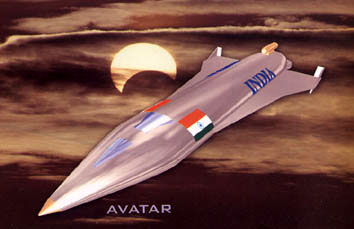LETHALFORCE
New Member
- Joined
- Feb 16, 2009
- Messages
- 29,968
- Likes
- 48,929
http://www.domain-b.com/aero/20080827_drdo.html

Hypersonic Technology Demonstrator Vehicle (HSTDV)/ Avatar (Rebirth)
AvatarAn eight-meter technology demonstrator is being built by the Defense Research & Development Laboratory (DRDL) in Hyderabad and is due to be tested sometime in the coming months. The demonstrator vehicle, being developed in cooperation with Israeli Aerospace Industries (IAI), will be powered by a "Scramjet" engine that takes in oxygen from the atmosphere and burns liquid hydrogen.
The hypersonic prototype will apparently be a precursor to DRDO's Aerobic Vehicle for Hypersonic Aerospace Transportation (AVATAR).
According to senior DRDO officials, the primary function of the vehicle is to act as a "reusable missile launcher, one which can launch missiles, land ... and be loaded again for more missions."
The proposed AVATAR will be able to take off and land like an aircraft and will also be capable of placing a payload of 1,000kg in low-earth orbit.
AVATAR would take off horizontally like conventional airplanes from conventional airstrips using turbo-ramjet engines that burn air and hydrogen. Once at a cruising altitude, the vehicle would use scramjet propulsion to accelerate from Mach 4 to Mach 8.
In this hypersonic cruise phase, an on-board system will collect air from which liquid oxygen will be separated. The liquid oxygen collected then would be used in the final flight phase, when the rocket engine burns the collected liquid oxygen and the carried hydrogen to attain orbit.
Re-usable Launch Vehicle The vehicle will be designed to permit at least a hundred re-entries into the atmosphere.
The non-military version, a Re-usable Launch Vehicle (RLV), is similar in concept and has the Indian Space Research Organisation as the lead development agency.
Hypersonic Technology Demonstrator Vehicle (HSTDV)/ Avatar (Rebirth)
AvatarAn eight-meter technology demonstrator is being built by the Defense Research & Development Laboratory (DRDL) in Hyderabad and is due to be tested sometime in the coming months. The demonstrator vehicle, being developed in cooperation with Israeli Aerospace Industries (IAI), will be powered by a "Scramjet" engine that takes in oxygen from the atmosphere and burns liquid hydrogen.
The hypersonic prototype will apparently be a precursor to DRDO's Aerobic Vehicle for Hypersonic Aerospace Transportation (AVATAR).
According to senior DRDO officials, the primary function of the vehicle is to act as a "reusable missile launcher, one which can launch missiles, land ... and be loaded again for more missions."
The proposed AVATAR will be able to take off and land like an aircraft and will also be capable of placing a payload of 1,000kg in low-earth orbit.
AVATAR would take off horizontally like conventional airplanes from conventional airstrips using turbo-ramjet engines that burn air and hydrogen. Once at a cruising altitude, the vehicle would use scramjet propulsion to accelerate from Mach 4 to Mach 8.
In this hypersonic cruise phase, an on-board system will collect air from which liquid oxygen will be separated. The liquid oxygen collected then would be used in the final flight phase, when the rocket engine burns the collected liquid oxygen and the carried hydrogen to attain orbit.
Re-usable Launch Vehicle The vehicle will be designed to permit at least a hundred re-entries into the atmosphere.
The non-military version, a Re-usable Launch Vehicle (RLV), is similar in concept and has the Indian Space Research Organisation as the lead development agency.
Last edited:
